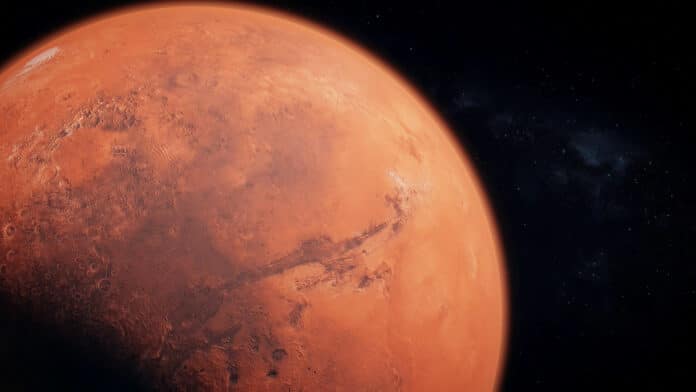Manufacturing and repairing structural components in space is critical for future space missions to Moon, Mars, and beyond the International Space Station. To make this idea possible, additive manufacturing (AM) techniques can fabricate bottom-up and layer-by-layer structures using available in situ resources. However, powder-based AM methods deal with various challenges in microgravity compared to extrusion-based techniques.
Scientists at Washington State University have come up with a new idea. They found that a small amount of simulated crushed Martian rock mixed with a titanium alloy made a stronger, high-performance material. This method can one day be used on Mars to create tools or rocket parts.
The components were created using Martian regolith, a black powdery substance designed to resemble the stony, inorganic material found on the surface of the red planet. The regolith was used in amounts ranging from 5% to 100%.
Amit Bandyopadhyay, a corresponding author of the study, said, “While the parts with 5% Martian regolith were strong, the 100% regolith parts proved brittle and cracked easily. Still, even high-Martian content materials would be useful in making coatings to protect equipment from rust or radiation damage.”
“In space, 3D printing has to happen if we want to think of a manned mission because we cannot carry everything from here. And if we forgot something, we cannot come back to get it.”
In 2011, Bandyopadhyay and his team used 3D printing to create parts for NASA out of lunar regolith, or mimicked crushed moon rock, to show that this concept was feasible. Since then, the technology has been adopted by space agencies, and the International Space Station now has its 3D printers to produce materials on-site and for experiments.
For this study, Bandyopadhyay and graduate students Ali Afrouzian and Kellen Traxel used a powder-based 3D printer to mix the simulated Martian rock dust with a titanium alloy, a metal often used in space exploration for its strength and heat-resistant properties.
The materials were heated to a temperature of more than 2,000 degrees Celsius by an intense laser (3,632 F). Then, the scientists were able to manufacture a variety of sizes and shapes using the melted mixture of Martian regolith-ceramic and metal material. Once cooled, scientists evaluated the material’s durability and strength after it had cooled.
Bandyopadhyay said, “The ceramic material made from 100% Martian rock dust cracked as it cooled, but it could still make good coatings for radiation shields as cracks do not matter in that context. But just a little Martian dust, the mixture with 5% regolith not only did not crack or bubble but also exhibited better properties than the titanium alloy alone, which meant it could be used to make lighter pieces that could still bear heavy loads.”
“It gives you a better, higher strength and hardness material, so that can perform significantly better in some applications.”
“This study is just a start, and future research may yield better composites using different metals or 3D-printing techniques.”
“This establishes that it is possible, and maybe we should think in this direction because it’s not just making plastic parts which are weak but metal-ceramic composite parts which are strong and can be used for any structural parts.”
Journal Reference:
- Ali Afrouzian, Kellen D. Traxel, Amit Bandyopadhyay. Martian regolith—Ti6Al4V composites via additive manufacturing. International Journal of Applied Ceramic Technology. DOI: 10.1111/ijac.14136
